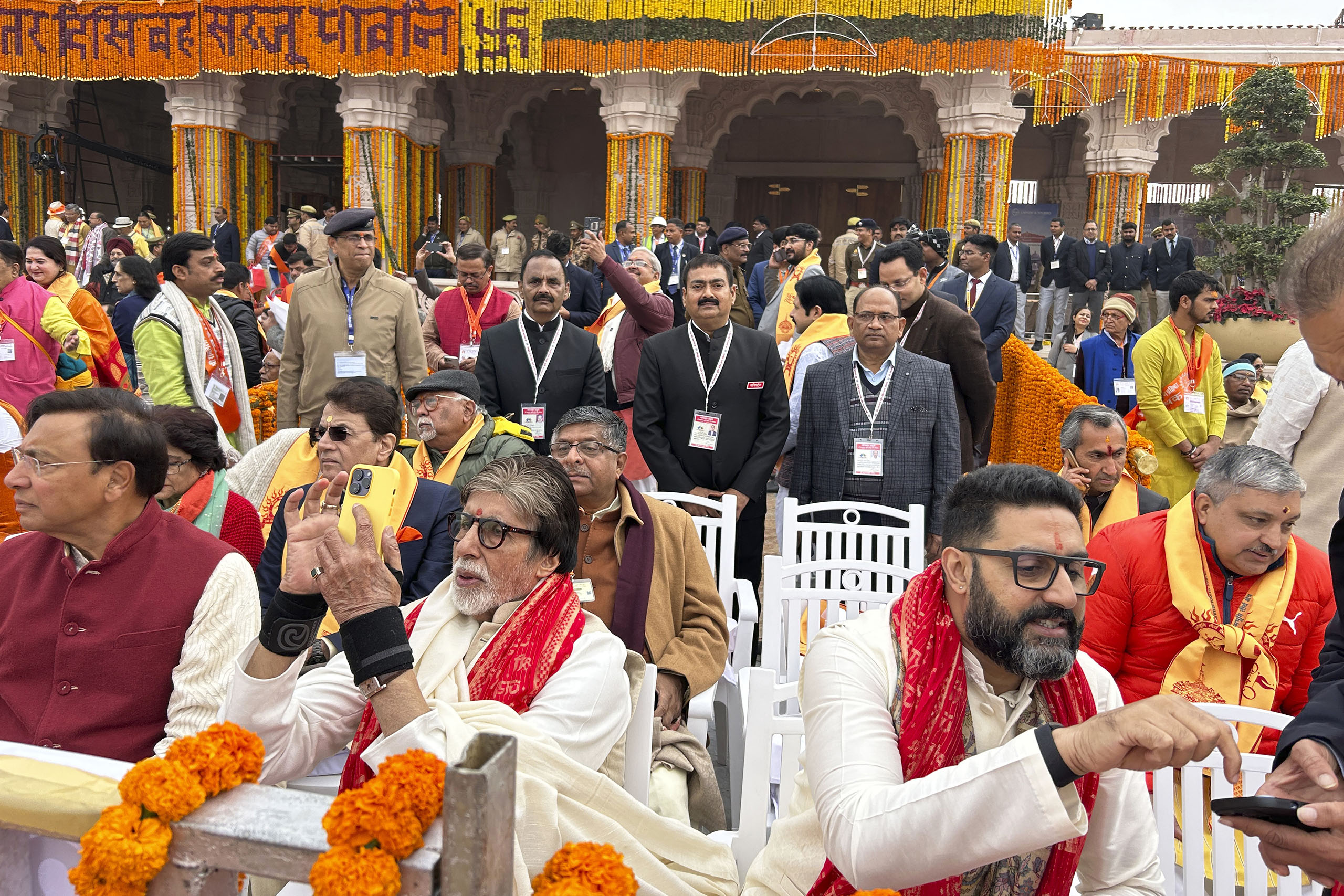India’s eighteenth general elections are only weeks away, a thumping victory for Narendra Modi and his Bharatiya Janata Party is predicted, and I’m watching Bollywood movies from 1977 to remind myself of how much the country’s mood has changed.
That was the year when Indira Gandhi ended her seventeen months of authoritarian rule (“the Emergency”) and called elections she expected to win. It was a make-or-break decision: if she prevailed, her opponents feared she would cement the authoritarianism of the Emergency.
Critics have described the spirit of prime minister Modi’s government during the past few years as “the Emergency you have when you’re not having an Emergency.” Techniques to harass your foes, pioneered by Mrs Gandhi and her cronies, have been deployed by the BJP with the efficiency of modern management and the relentlessness of digital technology.
In the elections of 1977, Indira Gandhi and her Congress party lost decisively to a hastily formed alliance of old politicians, some of whom had been jailed during the Emergency. A varied crew, they included fist-shaking socialists, heavyweight dropouts from Congress and future BJP prime minister Atul Bihari Vajpayee. They formed a government committed to undoing the excesses of the Emergency. India, they promised, would get a new start. Voters seemed to share their hope.
The top box-office film that year, Amar, Akbar, Anthony, had everything a Hindi film of its time needed: big stars, including the young Amitabh Bachchan, music, dancing, car chases, crime, murder, slapstick comedy and a happy ending. It was also cheap: filmed in a month entirely in Mumbai.
The plot carried a message. Three small boys are abandoned and separated. Amar is found and raised by an upright Hindu policeman, Akbar by a kindly Muslim tailor and Anthony (Bachchan) by a Catholic priest. Three filmic hours later, the brothers discover each other and together vanquish the criminals who have caused their distress; the family is reunited; the blind mother has her sight restored; the ne’er-do-well father repents, rejoices at the unity of the family — and is packed off to jail.
You don’t have to be into semiotics to get the message about national unity and “out of many, one.” Amar, Akbar, Anthony was so popular it got remade in three south Indian languages, each with a locally appropriate name change (including John, Jaffer, Janardhanan in Malayalam, the language of Kerala).
Today, a number of recent films and those announced for 2024 pack a different punch. They focus on international enemies working to destroy India. Pathaan, the box office favourite of 2023, is about international terrorists, viruses and cloak-and-dagger struggles between Indian secret agents and evil-doers in the employ of shadowy figures in Pakistan. It has earned hundreds of millions of dollars worldwide.
This year’s previewed films don’t pussyfoot around when it comes to messaging. The new releases include Bastar, focused on the Naxalites, murderous would-be revolutionaries in a rugged district in central India who killed more than seventy paramilitary police in 2010. “Urban Naxalite” is a common term of abuse for human rights activists and critics of the BJP government. In the film’s trailer, a police officer says that those “supporting” Naxalites “are pseudo-intellectuals, Left liberals” and promises to gather them in the street “and shoot them in public view.”
Pro-government? On the contrary, says the producer, it’s “pro-India”: “Our film talks about what is good for India. Now, if the BJP speaks similarly, it is their political stand.”
Another example with a political kick: Swantantrya Veer Savarkar (“freedom warrior Savarkar”). A prolific real-life writer and translator, Vinayak Damodar Savarkar (1883–1966) was imprisoned for years on the Andaman Islands for complicity in plots to murder British officials. He later became a leader of the Hindu Mahasabha and a favourite ideologue of the BJP. Savarkar was never incriminated in the murder of Mahatma Gandhi, but he didn’t much like Gandhi either. Savarkar “does not hate Gandhi but hates non-violence,” says film’s director.
Kunal Purohit, author of H-Pop: The Secretive World of Hindu Pop Stars, an impressive new book on Hindu-supremacism in popular music and publishing, estimates that ten of the films due for pre-election release demonise Muslims and opponents of Hindu ascendancy.
Films like these highlight the political contest going on in Indian popular culture via the country’s digitisation and its almost 900 million broadband subscribers. The BJP and its many subsidiaries are drowning out other voices.
The film business offers another significant angle on electoral politics. The films mentioned above, all in Hindi, come out of Mumbai (Bollywood). But the south Indian film industry, based in Hyderabad and Chennai, has “taken over the commercial and critical reins,” according to one of India’s most experienced film critics. The south, on this view, is where the most original and successful films are being generated.
The south Indian film that made movie people around the world pay attention, and crowds flock to the theatres, is the Telugu-language RRR, set in colonial times. The British and a Muslim prince provide the main villains. It is an expensive production with spectacular fight scenes and box office collections estimated at A$230 million internationally. (“A Netflix top 10 hit in 62 countries,” according to the streaming service, which screens a Hindi version).
South India will be a key focus in the coming elections. Just as its films are enjoying wide success, the region is registering India’s most impressive economic activity and social statistics. The telling number is estimated GDP per person, which is more than four times greater for the southern states than for India’s two most populous states, Uttar Pradesh and Bihar in the Hindi-speaking north. Together, UP and Bihar are home to about 25 per cent of India’s 1.4 billion people; the five southern states have 20 per cent. Female literacy, infant mortality and life-expectancy data are all better in the south.
Mr Modi and the BJP have had notable success in only one of the five southern states, Karnataka (capital, Bengaluru), where they won twenty-five (out of twenty-nine) parliamentary seats in 2019. But the BJP lost state elections to the Congress last year and didn’t hold a single parliamentary seat from Andhra Pradesh, Tamil Nadu or Kerala in the 2019 parliament.
On the surface, this inability to win in the south doesn’t matter. The BJP doesn’t need the south to win national elections, and that advantage will grow if a redistribution of seats, which hasn’t happened for fifty years, is carried out next year. The number of seats will be increased and reapportioned on the basis of population. On those calculations, the five southern states together will elect only about fifteen more members than Uttar Pradesh alone.
To people in the south, this looks like power being embedded in regions with poor records in health, education and economic growth. The feckless will be rewarded at the expense of the virtuous. That impression doesn’t fit well with Mr Modi’s frequent proclaiming that his main mission is economic development and material prosperity.
With victories seemingly assured in much of the Hindi-speaking north, the BJP is throwing talent and money at the southern states and at West Bengal. All these states have their own languages written in distinctive scripts, and they don’t regard the BJP’s pressure to use Hindi as the national language of Bharat (the BJP’s preferred name for India) with great enthusiasm.
Opposition leaders around India have as much reason today as in 1977 to be apprehensive about their futures in the event of a thundering victory for the government. Nevertheless, an attempt last year to coordinate opposition election campaigning has fallen apart even before the election dates were announced. Key political leaders in West Bengal, Bihar and Odisha have either aligned with the BJP or, in West Bengal, decided to fight on their own. Elsewhere, the BJP picks off potential adversaries with offers they can’t refuse.
Congress, the only opposition party with national recognition, is frail and easy to deride. Rahul Gandhi, its fifty-three-year-old leader, has few qualifications other than being the descendant of three prime ministers, Jawaharlal Nehru, Indira Gandhi and Rajiv Gandhi. His elderly Italian-born mother, Sonia, is still part of decision-making.
A big BJP victory will assure the party of fifteen years of power from 2014 to 2029. It will embolden the party to incorporate in the constitution provisions advocated before independence by the ideologues of Hindu supremacy. One of those goals was a centralised government in which the states would be simply implementers of the national program. Changing from a parliamentary to a presidential system has also been discussed in the past.
The long-term project of the BJP and the Hindu-supremacist Rashtriya Swayamsevak Sangh movement, of which Mr Modi was a member from adolescence, is an India in which all citizens subscribe to a common version of what it is to be a Hindu. Non-Hindus may continue to live in India but they must be prepared to be at the back of every queue and expect no favours from the state. In this way, Bharat will reclaim its pre-Muslim, pre-British glory.
Today, someone making an updated version of Amar, Akbar, Anthony might feel the need to recognise how the spirit of the times has changed. The film would tell how a brave Hindu boy saved his two hapless brothers, his blind mother and his country from powerful internal and external enemies. It might also be a good idea to call the film Modi! Modi! Modi! •




